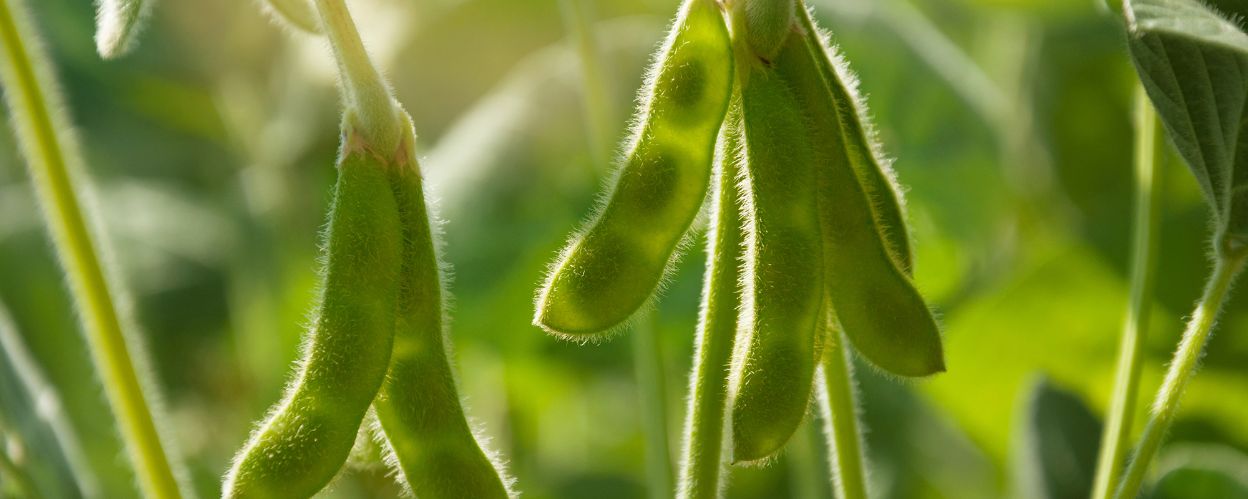
Soybean
Soybean is a versatile crop increasingly grown in temperate climate regions. It is important, however, to provide the soybean plants with sufficient nutrients to ensure the high quality of the harvested products. These account for over 85% of global production.
Soybean production locations
The soybean belongs to the legume family and can be grown in the tropics, subtropics as well as in temperate climate regions of the world. The largest soybean producers are the United States, Brazil, Argentina, China and India.
Soy - versatile
Soybean is an important source of high quality protein and oil. With an average protein content of 40% and an oil content of 20%, the soybean has the highest protein content of all crops. Due to its high protein, oil, and carbohydrate content, the soybean can be used in a wide variety of ways. The oil obtained has high digestibility and contains no cholesterol. Furthermore, soybean press cake, a by-product of oil production, is used as animal feed in many countries due to its high protein content.
The most important nutrients for soybeans
Potassium - for high yield and healthy soybean plants
Especially during blossom, soy needs adequate sustenance of potassium (K), due to its water demand being highest in this phase. Potassium supply has a significant influence on the yield and quality of the soybean.
- Potassium serves as an enzyme activator, for osmoregulation and for the transportation of assimilates such as starch and sugar.
- Potassium is needed for carbohydrate and protein metabolism, and therefore for vegetative growth and seed and pod formation.
- Adequate potassium supply reduces failure losses.
- Potassium promotes the formation of root nodules (nitrogen fixation by rhizobia).
- Soybeans with an adequate potassium supply show higher water use efficiency (unit water/unit dry matter) and lower transpiration losses. The highest water demand is in the phases of vegetative development, as well as flowering and pod filling
- Potassium has a positive effect on quality by reducing the number of shriveled, rotten and discolored beans.
Magnesium and sulfur - for optimum yield and quality
Magnesium
Magnesium (Mg) is an important component in soybean production, but its importance is often underestimated. The soybean is a very fast-growing crop requiring larger amounts of magnesium for photosynthesis as well as protein formation. Magnesium is also important for the nutrition of rhizobia.
- Magnesium is the central atom of chlorophyll and therefore ensures healthy, green leaves and a good photosynthesis.
- Magnesium is essential for the transportation of starch from the leaves into the pods and beans.
- Magnesium is needed in all energy-consuming metabolic processes, such as protein and oil synthesis.
- In acidic soils, magnesium attenuates root growth depression caused by aluminum toxicity.
Sulfur
Sulfur (S) is needed for the formation of proteins and therefore for the formation of root nodules (rhizobia).
- A reduced number of rhizobia reduces N2 fixation, which can lead to yield losses.
- The synthesis of oleic and fatty acids requires not only an adequate magnesium supply, but also a sulfur supply in line with requirements.
- Sulfur promotes oil formation and improves extractability, and also has a direct influence on soybean quality.
- As a result of the above functions, sulfur - like magnesium - has a positive effect on soybean yield.
Boron and manganese - for optimum utilization of the yield potential of soybeans
Boron
- Boron is involved in cell wall formation, water balance as well as the synthesis of energy-rich assimilates, such as sugars and starch.
- Soybean plants deficient in boron often show reduced seed formation and small seeds of poor quality.
- Boron leads to improved nitrogen fixation and reduces sensitivity to aluminum toxicity.
- Boron contributes to the formation, development, and functionality of rhizobia
Manganese
- Manganese activates a variety of different enzymes and is therefore essential for plant metabolism.
- Manganese is needed for the formation of chlorophyll as well as for the conversion reaction of nitrate into proteins and for the formation of amino acids.
- Manganese improves the disease resistance of soybean plants.
Fertilization recommendation for soybean plants
The aim of fertilization is to maintain soil fertility to enable the natural yield potential to be exploited in the long term. Fertilization recommendations are listed below, based on the nutrient removal of the main crop on the basis of optimum soil nutrient contents (in Germany, soil content class "C"). The total nutrient removal of a crop is calculated by removing the main crop (e.g. grain, tuber, beet) and the crop residues (e.g. straw, haulm, leaves). If the crop residues remain on the land, only the nutrient removal from the main crop product must be replaced. Allowances for site-specific losses due to leaching, fixation, or erosion are not included.
Fertilization should only be applied based on soil analysis and local fertilizer recommendations, as well as the nutrient balance of the crops grown in the rotation. In addition, the available amount of water as well as tillage must be taken into account.
Recommendation for soil fertilization
Soybean has limited tolerance to chloride. Application of potassium chloride in the order of more than 50 kg K2O / ha should not be placed directly next to the seed during planting, as emergence damage may occur. In this case, a divided administration with 1/3 at planting and 2/3 will be applied during the growing season, about 30 days later. In case of nutrient deficiency, a corrective fertilization can be applied to obtain a sufficiently high yield.
Fertilization with PatentKALI provides the nutrients potassium and magnesium in the right proportions and prevents nutrient competition. It also contains sulfur, which is still important for soybeans.
PatentKALI and ESTA Kieserit are approved products for organic farming.
Product recommendation



Recommendation for foliar fertilization
For foliar fertilization in soybeans, epsoTOP has proven to be particularly efficient for supplementing magnesium and sulfur. Mixing with urea to specifically compensate for any nitrogen deficiencies is possible in the same ratio. In soils with heavy rainfall with a predisposition to nutrient deficiency or in situations that may cause boron or manganese deficiency (heavy liming), foliar fertilization with micronutrients (EPSO® Microtop or EPSO® Combitop) is recommended.
Application is recommended from stage 14-16 as a 5% solution (5 kg in 100 l of water).
